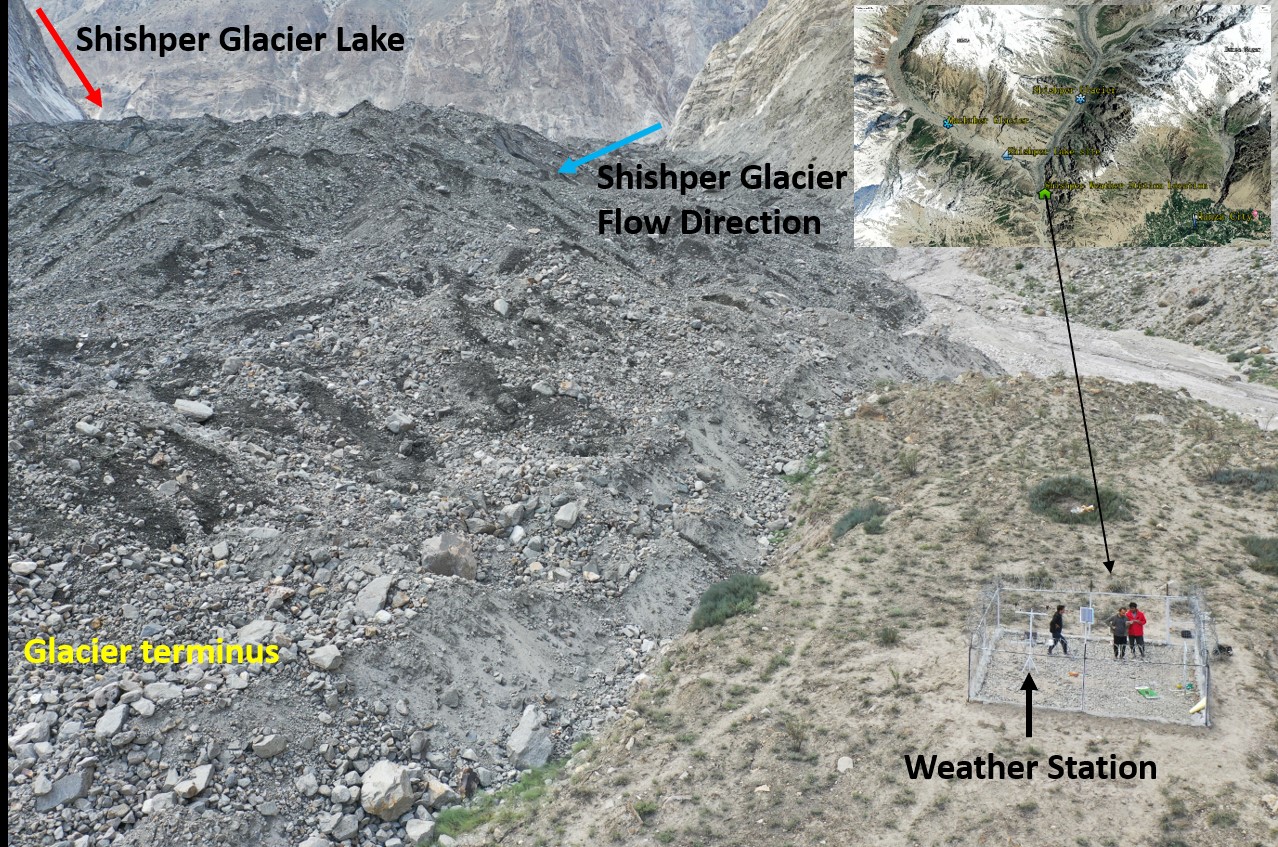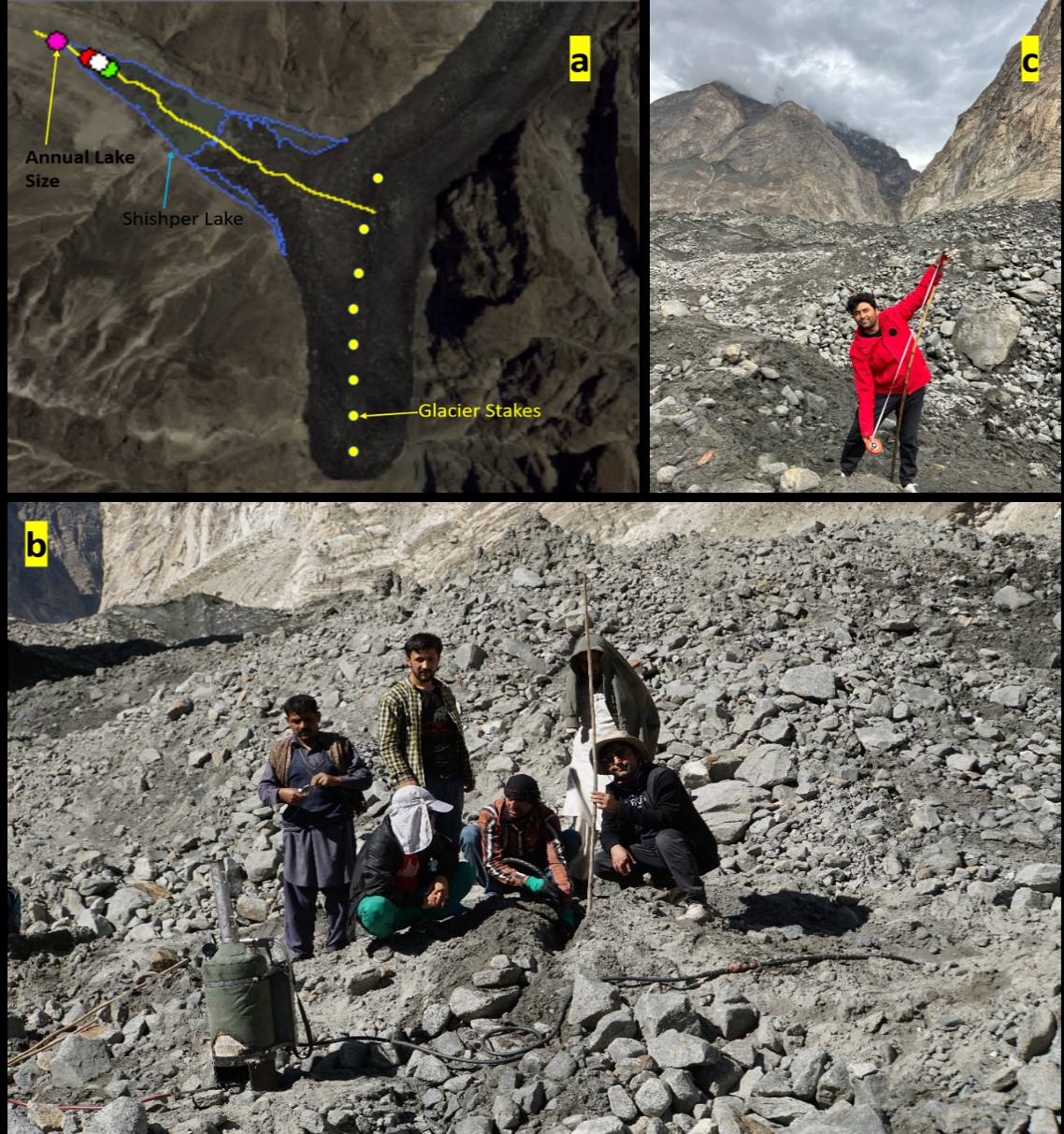
The first Jointly Installed Automatic Weather Station in the central Karakorum Between China Pakistan Joint Research Center on Earth science (CPJRC) and Karakorum International University (KIU) Gilgit-Baltistan Pakistan
Publisher: 中国-巴基斯坦地球科学研究中心网站
time: 2022-09-06
Automatic Weather Station:
After several field expeditions to investigate the Shishper glacier in Hunza, we installed a weather station and glacier stakes under Dr. Bazai’s supervision to monitor the glacier behavior in response to climate. Dr. Bazai had continuously monitored the Shishper glacier since 2019 when it began to surge. After four years duration, the glacier almost surged for 2 Km and produced 4 GLOF events, which were responsible for damaging Karakorum Highway (KKH), washed-away KKH bridge, 2 powerhouses, water supply channels, irrigation water supply channels, destroying more than 10 houses and damaged more than 20 house and eroded agricultural land and so on. Hunza basin in the Karakorum region is the highest producing natural hazards basins, such as GLOF, avalanches, Debris flow, mudflow and flashflood. For monitoring the metrological, hydrological, and hazardous activities of the shishper glacier, the first joint weather station was installed on 31 July 2022 between CPJRC and KIU on the Shishper glacier at an Elevation of 2550 m asl in Central Karakorum.

Figure 1Working on the installment of Shishper glacier weather station equipment (Photo: Bazai /CPJRC)
The weather station is installed close to the glacier terminus at a very safe place, which would be used for a long time and have the capacity to install more monitory equipment. The station consists of the following sensors, Air Temperature, Relative Humidity, Rain gauge, Solar radiation, Wind speed and wind direction, Soil moisture and soil temperature and measuring ice temperature. All sensors are configured to retrieve data on a monthly basis. The three sensors, Soil moisture and soil and ice temperature, were installed outside the weather station and close to the glacier to investigate and enhance the understanding of subsurface seasonal change activities. This weather station is the first step of the weather station network that CPJRC and KIU designed to install in the Karakorum region to compile the real ground data and enhance the understating of glaciers' behavior in response to westerlies' monsoons and climate change.

Figure 2 Expedition members pose for a photo after installing automatic weather station equipment on Shishper Glacier, Hunza basin, Iqtidar Hussain is running HOBO, and Dr. Bazai is using a UAV for Photo (Photo: Bazai /CPJRC)
Glacier Mass Balance Stakes:
To retrieve a compact data set and enhance the understanding of glacier behavior, we also installed glacier mass balance stakes on the glacier to investigate the melting rate and mass balance of the shishper glacier and also to investigate the conduit blocking activity during the surge and in the high melt season. Besides, we are also looking at the rate of melt of glacier surges and non-surge glaciers in the central Karakorum. Eight glacier mass balance stakes were installed at a distance of 250 m on the Shishper glacier terminus to the confluence point (2500 to 2700 m asl, respectively). The depth of the stakes was 25 m, and the data retrieved enteral was kept on a monthly basis.

Figure 3 Identifying, installing and measuring stakes on shishper glacier with team members Dr Bazai (Photo: Qaiser Khan /KMC student)
Permafrost Data Logger:
A recent focus of our cryosphere monitoring relates to better understanding permafrost in our field sites in the Karakorum. Due to climate change, the permafrost region's contribution is highly observed for triggering the debris flow and mudflow in the sunny weather in the Hunza basin. We have identified more than 8 gullies that are responsible for such events. But we have very limited data. These gullies' upper reaches are mostly permafrost, which is needed to understand their contribution to such hazards. Thus, we have installed four permafrost data loggers at an elevation of 4500 to 5000 m asl at Khujrab pass (the border of Pakistan and China) with a depth of 10 cm in most permafrost regions. Besides, this also will help us better understand the effect of changing permafrost on the hydrology of high mountain catchments in the Karakorum.

Figure 4 Working of installing permafrost data logger at Khunjrap pass with Iqtidar Hussain (Photo: Qaiser Khan /KMC student)